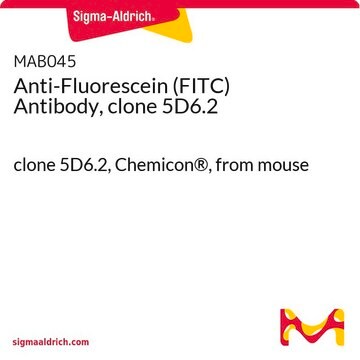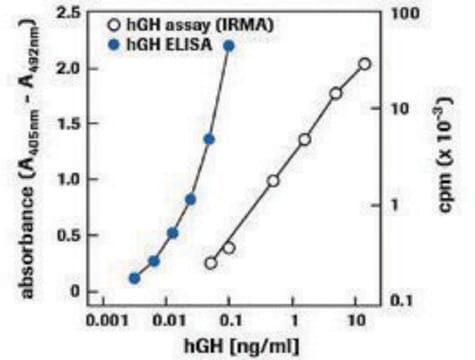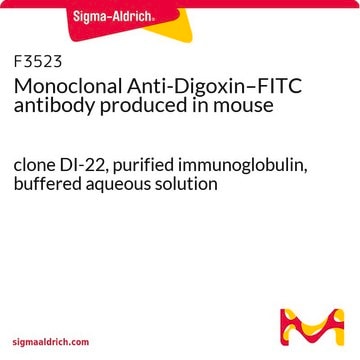11426320001
Roche
Anti-Fluorescein
from mouse IgG1 (clone B13-DE1)
Synonym(s):
antibody
Sign Into View Organizational & Contract Pricing
All Photos(1)
About This Item
UNSPSC Code:
12352200
Recommended Products
biological source
mouse
conjugate
unconjugated
antibody form
purified immunoglobulin
antibody product type
primary antibodies
clone
B13-DE1, monoclonal
form
lyophilized
packaging
pkg of 100 μg
manufacturer/tradename
Roche
isotype
IgG1
storage temp.
2-8°C
General description
Monoclonal antibody to fluorescein.
The detection of bound antibody can be carried out directly in one step using an anti-mouse Ig fluorochrome/enzyme conjugate, or in a two-step procedure with anti-mouse Ig fluorescein and, subsequently, anti-fluorescein enzyme conjugate.
The antibody does not contain any protein and can hence be used for coating and labeling.
Contents
Lyophilizate, stabilized
The detection of bound antibody can be carried out directly in one step using an anti-mouse Ig fluorochrome/enzyme conjugate, or in a two-step procedure with anti-mouse Ig fluorescein and, subsequently, anti-fluorescein enzyme conjugate.
The antibody does not contain any protein and can hence be used for coating and labeling.
Contents
Lyophilizate, stabilized
Specificity
The monoclonal antibody reacts with free and bound fluorescein.
Application
Use Anti-Fluorescein for the detection of fluorescein-labeled compounds using:
- ELISA
- Immunohistocytochemistry
- In situ hybridization
- Western blot
Preparation Note
Working concentration: Working concentration of conjugate depends on application and substrate. The following concentrations should be taken as a guideline:
Working solution: Phosphate buffered saline, pH 7.4
Using water instead the antibody can precipitate.
- ELISA: 2 to 4 μg/ml
- Immunohistocytochemistry: 0.5 to 2 μg/ml
- In situ hybridization: 0.2 to 0.4 μg/ml
- Western blot: 0.5 to 2 μg/ml
Working solution: Phosphate buffered saline, pH 7.4
Using water instead the antibody can precipitate.
Reconstitution
Add 1 ml double-distilled water to a final concentration of 100 μg/ml.
Reconstitute for 15 minutes.
Reconstitute for 15 minutes.
Other Notes
For life science research only. Not for use in diagnostic procedures.
Not finding the right product?
Try our Product Selector Tool.
signalword
Warning
hcodes
Hazard Classifications
Aquatic Chronic 3 - Skin Sens. 1
Storage Class
11 - Combustible Solids
wgk_germany
WGK 2
flash_point_f
does not flash
flash_point_c
does not flash
Certificates of Analysis (COA)
Search for Certificates of Analysis (COA) by entering the products Lot/Batch Number. Lot and Batch Numbers can be found on a product’s label following the words ‘Lot’ or ‘Batch’.
Already Own This Product?
Find documentation for the products that you have recently purchased in the Document Library.
Customers Also Viewed
J Spielmann et al.
BMC obesity, 4, 24-24 (2017-07-12)
Obesity was identified as a major risk factor for malignant diseases, but underlying mechanisms remain unclear. Natural killer (NK) cells, a pivotal aspect of innate immunity, are capable of identifying and killing virally infected and tumor cells. Previous studies have
Ignacio E Schor et al.
Current biology : CB, 28(22), 3547-3561 (2018-11-06)
Long non-coding RNAs (lncRNAs) can often function in the regulation of gene expression during development; however, their generality as essential regulators in developmental processes and organismal phenotypes remains unclear. Here, we performed a tailored investigation of lncRNA expression and function
Comparing nucleic acid lateral flow and electrochemical genosensing for the simultaneous detection of foodborne pathogens.
Aissa A B, et al.
Biosensors And Bioelectronics, 88, 265-272 (2017)
Yufeng Liu et al.
Oncology reports, 44(2), 499-508 (2020-07-07)
Apurinic/apyrimidinic endonuclease 1 (APE1) is a primary nuclear‑localized multifunctional protein in osteosarcoma. However, the cytoplasmic localization of APE1 was found to be functional and to increase with cisplatin resistance, yet the molecular mechanism is unknown. In the present study, we explored
María Fernanda Prado-Fernández et al.
Current issues in molecular biology, 46(7), 6885-6902 (2024-07-26)
Pereskia sacharosa Griseb. is a plant used in traditional herbal medicine to treat inflammation. We analyzed the phenolic content of P. sacharosa leaves (EEPs) by liquid chromatography-tandem mass spectrometry (LC-MS/MS) and investigated the anti-inflammatory properties of EEPs and its flavonoid
Our team of scientists has experience in all areas of research including Life Science, Material Science, Chemical Synthesis, Chromatography, Analytical and many others.
Contact Technical Service









